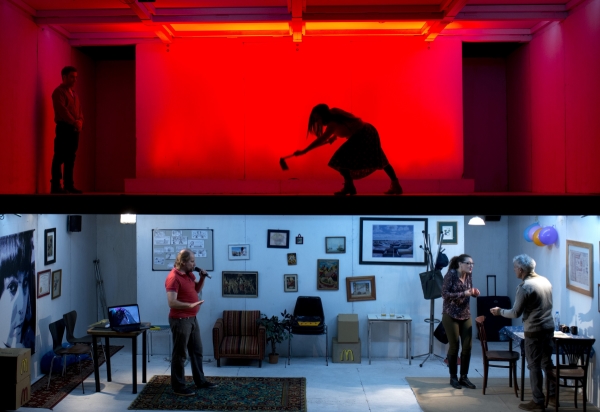Cineastas
Mariano Pensotti explores the impact of film at the Public Theater’s Under the Radar Festival.

(© Carlos Furman)
It would take us 92 years to continuously watch every movie ever made. We learn this little factoid at the end of Cineastas, an astounding theatrical tribute to moving pictures by Mariano Pensotti, which recently ran as part of the Public Theater's Under the Radar Festival. Reminiscent of the 1993 movie Thirty Two Short Films About Glenn Gould, Pensotti weaves together four different narratives to paint a portrait of a country, Argentina, and how, no matter what language you speak, cinema transcends all barriers.
The quartet of storylines revolves around different directors who are putting together their latest work. Gabriel (Javier Lorenzo) is a commercially successful filmmaker who guides his latest rom-com into the realm of existentialism when he's diagnosed with a terminal illness. Nadia (Juliana Muras) unexpectedly finds her first work a commercial hit and, at a loss for a followup, is assigned by a studio to direct a father-son reunion story. Mariela (Vanesa Maja) is a popular documentarian who decides to rediscover her roots through film. Lucas (Marcelo Subiotto) is a no-name who works at a local McDonald's and uses his fast-food career as inspiration.
Staged on a two-level set designed by Mariana Tirantte, Pensotti shows us the directors as they go through the motions of moviemaking and the flicks themselves, which are played out in a small nondescript room above the action. In a dazzling fashion, the writer/director finds intriguing ways to adapt elements that one could only see on-screen for the stage: cuts and fades, montages, long shots, close-ups — it's all there, and without the benefit of expensive equipment and high-quality editing software.
All of the performers, a list that's completed by Horacio Acosta, take on multiple roles. Distinctive choices make their characters and their motivations crystal clear. With a mere shift in windbreaker and location, Lorenzo can go from playing the wealthy director Gabriel to one of the sons in Nadia's film without breaking a sweat. From our viewpoint in the audience, it makes complete sense thanks to Pensotti's deft staging, which utilizes class-conscious costumes by Tirantte and stimulating lighting by Alejandro Le Roux that divides the piece from "movie" to "real life."
This is all part of Pensotti's grand plan, which turns the piece into a captivating anthropological study of the influence of film on people's lives. Dying Gabriel realizes that the only way he can show his legacy to his two-year-old daughter is through his art. To protest the unfair treatment of workers, Lucas makes a torture-porn film about a man who gets kidnapped and is forced to eat cold McDonald's hamburgers and dress as Ronald McDonald. These storylines, and the others, are all commentary-driven; Pensotti is making a boldfaced statement about the impact of cinema, but thanks to the ingenious treatment of the material, it never seems didactic. In fact, it's perhaps the most refreshing piece of film criticism in recent memory.








